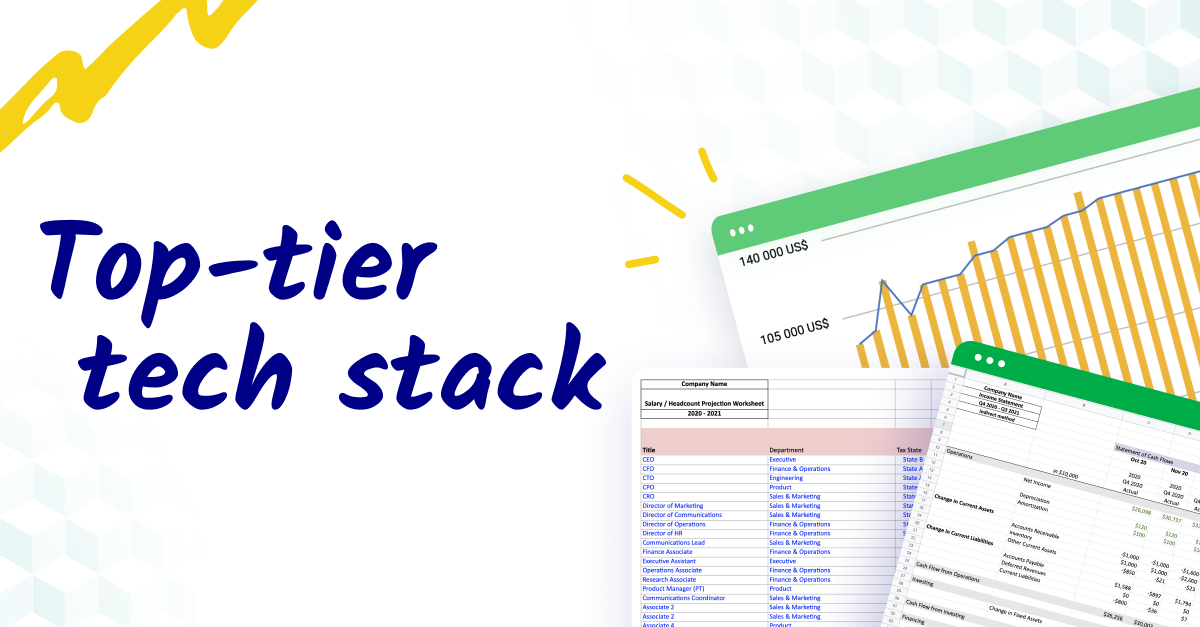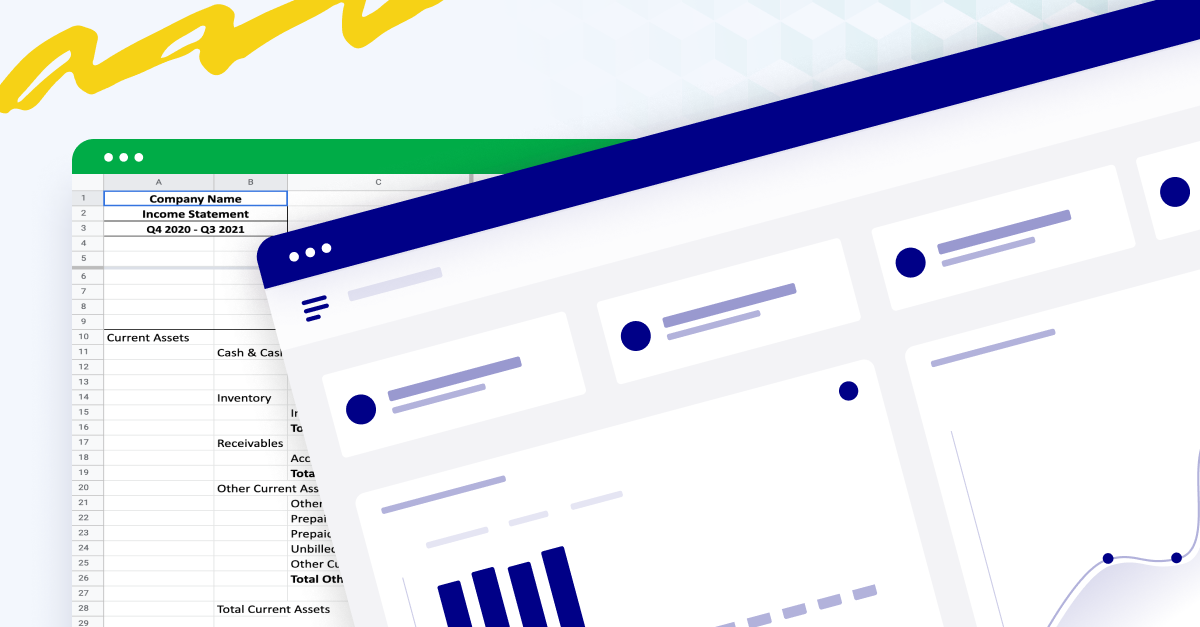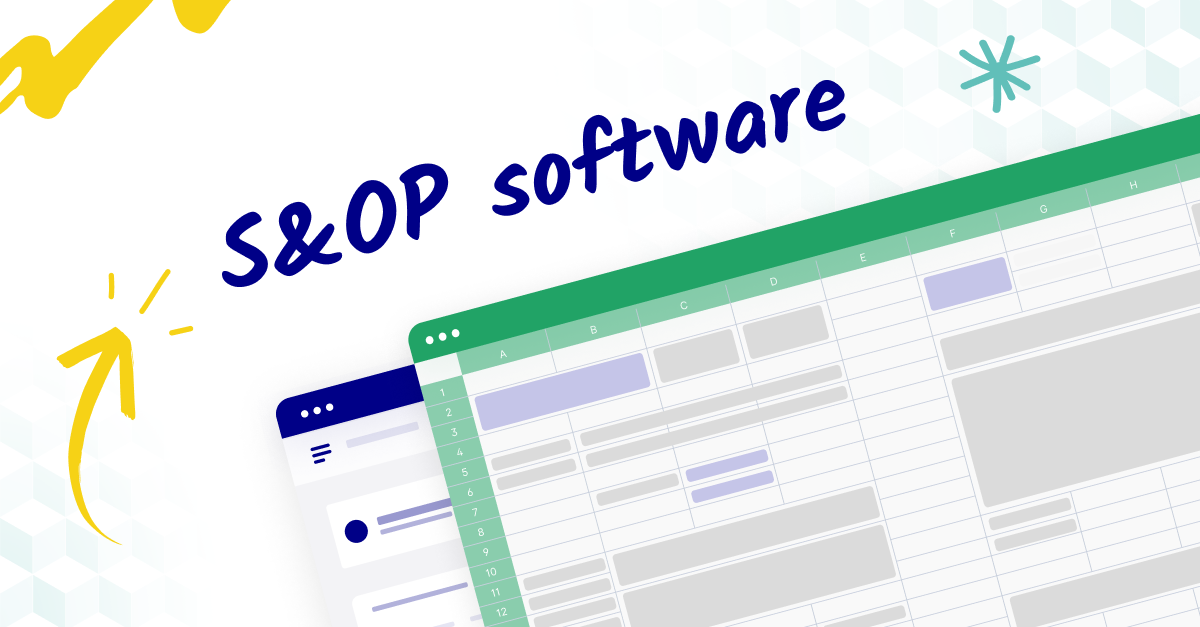The importance of a robust financial tech stack
Digital transformation is sweeping through the financial sector, redefining traditional roles and methodologies. In this evolving landscape, a sophisticated tech stack is crucial to drive efficiency, ensure accuracy, and support strategic initiatives.
Embracing technological advancements is no longer optional; it's a necessity for finance leaders committed to steering their organizations towards sustainable growth and resilience. With a comprehensive tech stack, finance professionals can anticipate market shifts and respond with agility, maintaining a competitive edge.
It's not just about staying current; it's about being proactive, using technology as the backbone that supports innovation and strategic foresight in financial operations.

What makes up a top-tier finance tech stack?
The versatility and completeness of your tech stack can dramatically influence operational efficiency and analytical depth. Here are the must-have components of a top-tier tech stack:
1. Financial planning and analysis (FP&A) software
Financial planning and analysis (FP&A) software is a critical component of a finance leader's tech stack, designed to centralize financial data for more in-depth analysis and forecasting.
Its primary role is to support budgeting, forecasting, and strategic planning processes, using historical data and analytics to guide decision-making. In a dynamic economic environment, FP&A software provides the necessary agility and insights for businesses to stay ahead.
Key benefits include:
- Comprehensive decision-making: Empowers leaders with robust analytics and forecasting, facilitating informed decisions based on trends, profitability analysis, and cash flow projections.
- Efficiency in budgeting: Enhances budgeting processes with automation, saving time and improving accuracy.
- Scenario modeling: Allows finance teams to simulate various economic scenarios, assessing risks and opportunities to strategically prepare for diverse business outcomes.
To learn more about which FP&A software might be the right fit for your business, check out our Ultimate Guide to FP&A Software. It includes a comprehensive list of the top FP&A software solutions on the market, such as Cube—a cloud-based platform that helps finance teams work anywhere so they can plan, analyze, and collaborate with speed and confidence.
Cube is built to work directly with most finance and business systems including ERP, CRM, HRIS, Business Intelligence systems, and more, meaning it will fit seamlessly into your growing tech stack. Cube also has bi-directional integration with Google Sheets and Microsoft Excel, which gives customers an incredible amount of versatility to choose the user experience that is right for them and their business teams.
2. Enterprise resource planning (ERP) systems
Enterprise Resource Planning (ERP) systems integrate all business operations, including procurement, manufacturing, services, sales, finance, and HR, providing a unified management platform. These systems are vital for finance leaders, delivering consistent, accurate, and real-time financial data across business units, enhancing internal communication and efficiency.
Key benefits include:
- Data uniformity: Ensures data consistency and integrity, which are foundational for reliable financial reporting and analysis.
- Automated workflows: Streamlines operations by eliminating repetitive manual tasks, thus improving operational efficiency.
- Improved collaboration: Promotes effective teamwork through integrated data systems, optimizing decision-making processes.
Some ERPs to consider are:
- NetSuite: NetSuite simplifies businesses by automating essential processes and giving real-time insights into financial and operational performances. It’s a customizable platform with enterprise-grade applications for different aspects of business management, including analytics, reporting, and global infrastructure.
- Intuit Quickbooks: QuickBooks by Intuit is simple to use and helps with managing payroll, inventory, taxes, time-tracking, and invoicing. You can also track expenses and cash flow and monitor reports and receipts.
- Sage Intacct: Sage Intacct is an ERP financial and inventory management system through real-time, multi-dimensional reporting. It automates accounting tasks to increase efficiency and productivity to streamline daily operations.
3. Accounting software
Accounting software is foundational to any finance tech stack, primarily handling the meticulous management of financial transactions and records. It serves as the bedrock for financial operations, automating routine tasks, ensuring precision in bookkeeping, and offering initial insights into a company’s financial health.
While it addresses these essential functions, it's pivotal to understand that this software lays the groundwork for the more strategic, data-driven analysis and planning performed by FP&A software. For finance leaders, accounting software guarantees the basics: enhanced compliance, efficient record-keeping, and a source of reliable data for further financial analysis.
Key benefits include:
- Error reduction: Minimizes human error in calculations and recurring transactions, ensuring meticulous financial records.
- Financial reporting efficiency: Simplifies and accelerates the creation of compliant financial reports.
- Cash flow management: Enables real-time monitoring of payables and receivables, crucial for effective cash flow strategies.
Some accounting software options to consider are:
- Sage 50, 100, 300: Sage offers a range of accounting solutions designed to serve the needs of small, medium, and large enterprises. These systems provide powerful accounting tools, simple to use with comprehensive customization options, and support various add-ons for enhanced functionality.
- Microsoft Dynamics Suite: Known for its adaptability and wide range of applications, Microsoft Dynamics provides more than just accounting solutions. It’s an integrated, versatile platform that supports finance, sales, customer service, and operations, with the capacity for customization based on business needs.
- Xero: Xero, popular with small and medium-sized businesses, provides an intuitive, cloud-based accounting platform. It includes features for invoicing, payroll, inventory management, and more, offering real-time visibility of financial status and performance.
4. Business Intelligence (BI) tools
Business Intelligence (BI) tools play a crucial role in transforming data into actionable insights. They enable organizations to analyze, visualize, and report data, supporting strategic and operational decision-making. For finance leaders, BI tools provide a profound understanding of market trends and business performance, directly influencing revenue and cost optimization strategies.
Key benefits include:
- Enhanced data insights: Delivers valuable insights from complex data, guiding leaders toward informed decisions that pinpoint market trends and opportunities.
- Customized reporting: Facilitates the creation of tailored reports, catering to the specific needs and queries of stakeholders.
- Predictive analysis: Employs historical data for forecasting future market trends, preparing businesses for evolving market conditions and competitive advantages.
Some BI tools to consider are:
- Tableau: Known for its advanced data visualization capabilities, Tableau makes it easier for businesses to see and understand their data, transforming the way they use analytics. It provides various customizations and allows integration with numerous data sources.
- Microsoft Power BI: This business analytics service provides interactive visualizations with self-service business intelligence capabilities. Users can create reports and dashboards by themselves, without needing to depend on information technology staff or database administrators.
- Looker: A part of the Google Cloud data suite, Looker goes beyond traditional BI. It provides high-level data exploration, real-time analytics, and a centralized platform for leveraging the latest data. Its modern interface and robust integration features with various data sources make it indispensable for businesses that need comprehensive insights.

Tips for strategically growing your finance tech stack
Expanding a finance tech stack requires careful strategy, prioritizing seamless integration, security, and future adaptability. Each facet is crucial in maintaining a system that's cohesive, secure, and prepared for the future of finance.
Here's how these aspects play a critical role and actionable steps for finance leaders:
Seamless integration
Your financial tools should interact seamlessly, acting as a unified entity rather than disparate pieces. This integration is crucial for real-time, accurate insights and strategic decision-making.
To ensure seamless integration, follow these tips:
- Opt for platforms that support API integrations: This ensures that new tools can communicate with your existing systems, facilitating real-time data transfer and process automation, which are crucial for timely and strategic financial decisions.
- Prioritize tools that offer out-of-the-box compatibility with your existing systems: Compatibility minimizes the struggles of integration, reducing downtime, and the resources used for custom development, making transitions smoother and more cost-effective.
- Conduct integration tests: Testing before full implementation helps identify and address issues early, ensuring the integration adds value without disrupting current operations.
Strong data security
Protecting financial data is paramount, necessitating tools with built-in, top-notch security features to prevent breaches that could jeopardize your organization's standing and compliance.
To ensure strong data security, follow these tips:
- Choose solutions with robust security measures: Utilizing encryption and multi-factor authentication defends against unauthorized access, protecting sensitive financial data and client information.
- Regularly schedule security audits and updates: Proactive security reviews identify potential vulnerabilities, ensuring your systems remain unassailable and trust in your financial operations is maintained.
- Train your team on security best practices: Continuous education fortifies human defense, reducing the likelihood of security lapses due to human error, a common vulnerability in financial operations.
Future-proofing and adaptability
The landscape of finance technology constantly evolves, which means it’s crucial that your tech stack can adapt to changing needs and emerging innovations.
To future-proof your tech stack and ensure adaptability, follow these tips:
- Invest in scalable solutions: Selecting scalable solutions means your tech stack can grow and adapt, accommodating increasing data volumes and more nuanced analytical needs without overhauling your entire system.
- Keep abreast of industry trends: Understanding emerging trends helps anticipate the direction of financial technology, allowing for early adaptations that keep your operations competitive and forward-thinking.
- Set regular intervals for tech stack assessments: Routine evaluations ensure your tools remain efficient, compliant, and aligned with industry best practices, maintaining your edge in a competitive marketplace.
By understanding the 'why' behind each step, finance and FP&A leaders will be better equipped to build a resilient, efficient, and adaptive tech stack. This strategic approach not only simplifies current operations but also positions the organization for sustainable growth and proactive responses to the future's financial challenges.
Conclusion: transform your tech stack in no time
Building a top-tier financial tech stack is an ongoing journey of improvement, not a one-time investment.
In the rapidly changing tech landscape, finance leaders need to stay vigilant, adapting their tools and strategies to continue delivering profound insights and top performance. It's time to assess your current tech arsenal and strategically plan for a future of innovation, growth, and long-term success.
Want to learn how Cube can take your tech stack (and your business) to the next level? Request a free demo today.



.png)









.png)





.png)

